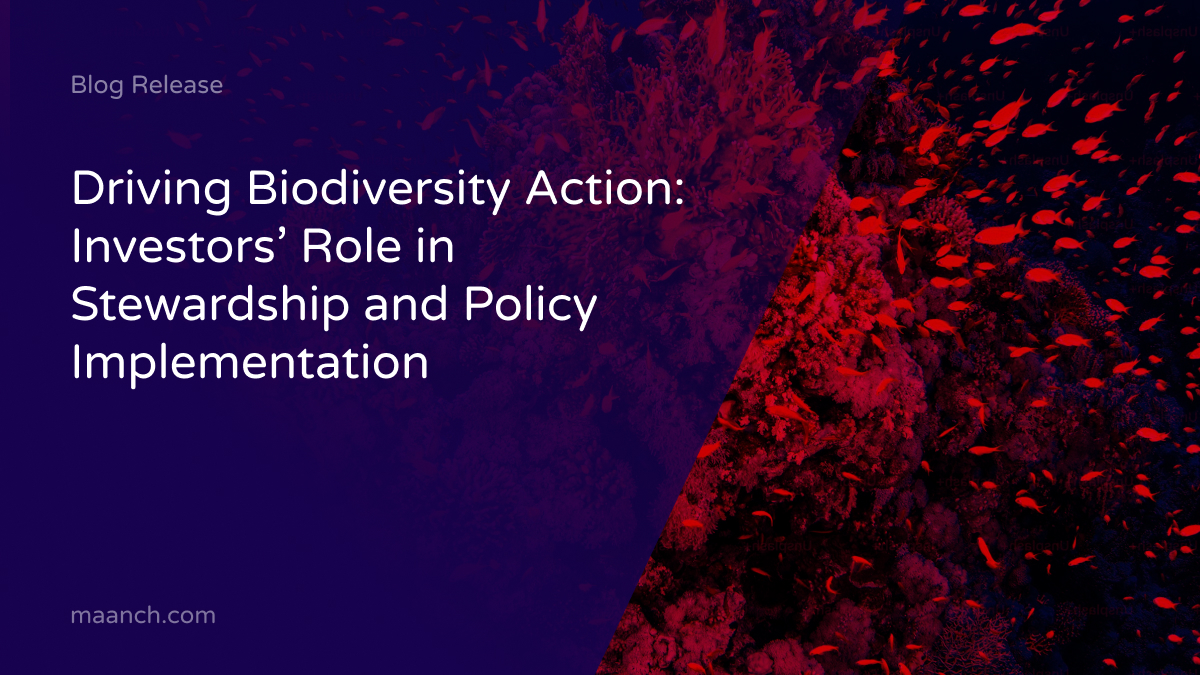At Maanch, we recently attended the workshop on “Taking Action on Nature” hosted by Principles for Responsible Investing focused on integrating biodiversity considerations into investment policies. The workshop raised a variety of crucial opportunities and challenges faced today, and how Investors have the potential to bridge both. In this blog, we will explore the Spring initiative recently put in place by PRI, the importance of implementing a Biodiversity policy and its challenges and finally the potential of Stewardship. Principles of Responsible investment put forward three pillars for the promotion of taking action on Nature: Stewardship, Policy engagements and Investment policies and practices.
Spring Initiative by PRI:
Spring is a Principles for Responsible Investing stewardship initiative for nature, convening investors to use their influence to halt and reverse global biodiversity loss by 2030. The initiative aims to address the systemic risk of nature loss to societies and long-term portfolio value creation by enhancing corporate practices on forest loss and land degradation. So far, the initiative has been endorsed by 204 Investors and 66 are participating in engagements with companies, representing $15 trillion in assets managed by investors endorsing Spring. The Spring investor statement sets out the initiative’s aims and approach in more detail.
The PRI’s Spring program revolves around:
- Stewardship & Engagement: Investors working together to address nature risks and engaging companies on biodiversity-related issues.
- Policy Development: Encouraging organisations to create comprehensive biodiversity policies that guide investment, governance, capital allocation, and reporting.
This initiative resembles other Collaborative engagement efforts such as Climate100+ and Net Zero Asset Owner Alliance. As we have seen in previous blogs, collaborative initiatives have tremendous potential for systemic change.
Developing a Biodiversity Policy:
PRI is leading the transition to a more responsible and integrated approach to including biodiversity in investment decisions. However, collaborative initiatives are not enough to respond to the current challenges. Investors must now individually set up and implement Biodiversity policies relating to their own investments. By doing so, Investors are providing a framework for investment and stewardship actions, aligning stakeholder expectations and addressing nature-related risks, such as deforestation.
The purpose of setting up a Biodiversity policy is to help guide investment decisions, stewardship actions, and reporting. It outlines why biodiversity is important and what actions the investor is taking. The policy should cover broader nature themes and address drivers like deforestation, progressively integrating biodiversity across all asset classes. Developing such a policy is vital for setting clear expectations, managing risks, and contributing to nature preservation while fostering transparency and collaboration in the investment process.
Components of the policy should include:
- Aims and Commitments: Define the scope of the policy (e.g., forests, oceans),
- Governance: Establish how biodiversity is managed within the organisation,
- Capital Allocation and Risk Management: Allocate resources to address biodiversity risks,
- Stewardship: Guide engagement with investee companies to ensure they act responsibly.
- Reporting: Set up mechanisms to track and disclose progress.
Challenges in Developing a Biodiversity Investment Policy:
Although implementing and developing a Biodiversity Investment policy is crucial for Investors today, there are still challenges and hurdles to overcome in order to make sure it is meeting its goal and intent. Developing a comprehensive approach across various asset classes is complex due to limited data and the difficulty of translating biodiversity issues into investment decisions.
There are a number of challenges faced by Investors including:
- Comprehensive Approach Across Asset Classes: Investors face difficulty in translating biodiversity issues into concrete investment strategies across different asset classes.
- Limited Data: A lack of decision-useful data makes it hard to understand biodiversity impacts, dependencies, risks, and opportunities.
- Internal Readiness: Many organisations want to ensure internal alignment and readiness before publishing a policy to avoid over-committing.
Indeed, we also recently covered in one of our blogs the Nature-Related Financial Disclosure Gap. Especially focusing on how the data challenge due to the lack of comprehensive and reliable data remains a significant hurdle. There are however some existing solutions to these challenges.
Solutions for Implementing a Biodiversity Policy:
The challenges in implementing a Biodiversity Investment policy can be remedied by multiple answers and practical solutions. Here is an overview of the main solutions available to Investors:
- Solutions:
- Guidance and Examples: Consult PRI’s guidance and other successful investor examples.
- Internal Promotion: Building internal awareness by presenting evidence from portfolio assessments.
- Progressive Integration: Start with integrating biodiversity in select areas and expand as the organisation becomes more capable.
- Iterative Process: Keep updating the policy as more data becomes available and relationships with external partners strengthen.
- Practical Approaches:
- Capacity Building: Train and build internal knowledge to better address biodiversity issues.
- External Collaboration: Work with data providers and partners to improve data collection and analysis. Investors are increasingly backing initiatives like the Finance for Biodiversity (FfB) Foundation and the Taskforce on Nature-related Financial Disclosures (TNFD) to enhance nature-related financial disclosures. These organisations are at the forefront of developing frameworks and standards to incorporate biodiversity and ecosystem services into investment decisions.
- Engagement with Companies: Set clear expectations for companies in the investment portfolio to address biodiversity challenges like deforestation and land degradation.
These measures ensure that organisations can both meet their biodiversity commitments and manage nature-related risks in a more informed and sustainable way.
Stewardship and Capacity Building:
The PRI workshop also emphasised the importance of investor stewardship. Lead investors work with companies to assess biodiversity risks and help align business practices with environmental goals. Overall, the workshop highlighted the critical role of investors in addressing biodiversity risks and advancing responsible investment practices aligned with nature conservation.
Some Investors including UBP have participated in Cambridge Institute for Sustainability Leadership’s new Engagement Guide. The newly published guide is to support the market-wide transformation towards a net-zero and nature-positive economy by evolving the interaction between banks and investment managers and their portfolio clients and investee companies. CISL’s ‘Let’s Discuss Nature with Climate Engagement Guide’ focuses specifically on the relationship between the financier and financed. The Guide aims to empower client-facing staff at banks and investment managers to support portfolio clients and investee companies to act on the opportunities, risks and compliance demands associated with nature and climate.
The Guide presents a five-phase approach (see diagram below) to integrate nature into existing engagements on climate. For each phase, this Guide provides details of the context and target outcomes, with helpful resources, guiding questions and ideas to support research and preparation efforts.
Source: University of Cambridge Institute for Sustainability Leadership (CISL). (2023). Let’s Discuss Nature with Climate: Engagement Guide. Cambridge, UK: University of Cambridge Institute for Sustainability Leadership.
Conclusion
In conclusion, investors play a pivotal role in driving biodiversity action through stewardship and policy implementation. By integrating biodiversity considerations into investment strategies, engaging with companies, and collaborating with key initiatives like PRI’s Spring, investors can mitigate nature-related risks while fostering long-term value. The challenges are clear, but solutions—ranging from internal capacity building to enhanced data collaboration—offer a pathway to success.



